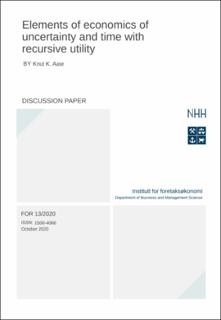Elements of economics of uncertainty and time with recursive utility
| dc.contributor.author | Aase, Knut K. | |
| dc.date.accessioned | 2020-11-05T12:26:36Z | |
| dc.date.available | 2020-11-05T12:26:36Z | |
| dc.date.issued | 2020-10-30 | |
| dc.identifier.issn | 1500-4066 | |
| dc.identifier.uri | https://hdl.handle.net/11250/2686569 | |
| dc.description.abstract | We address how recursive utility affects important results in the theory of economics of uncertainty and time, as compared to the standard model, where the focus is on dynamic models in discrete time. Several puzzles associated with the standard theory are less puzzling with recursive utility, even if this type of preference representation seems close to the standard one at first sight. The basic difference is that recursive utility allows a form of separation of consumption substitution from risk aversion. This also means that the timing of resolution of uncertainty matters. In dynamic models, however, this turns out to be rather crucial steps. | en_US |
| dc.language.iso | eng | en_US |
| dc.publisher | FOR | en_US |
| dc.relation.ispartofseries | Discussion paper;13/20 | |
| dc.subject | Recursive utility | en_US |
| dc.subject | axioms | en_US |
| dc.subject | scale invariance | en_US |
| dc.subject | utility gradients | en_US |
| dc.subject | the equity premium puzzle | en_US |
| dc.subject | precautionary savings | en_US |
| dc.title | Elements of economics of uncertainty and time with recursive utility | en_US |
| dc.type | Working paper | en_US |
| dc.source.pagenumber | 38 | en_US |
Files in this item
This item appears in the following Collection(s)
-
Discussion papers (FOR) [564]
